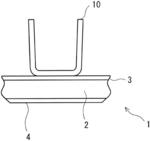
基本信息:
- 专利标题: Aluminum alloy clad material
- 申请号:US16916441 申请日:2020-06-30
- 公开(公告)号:US11027373B2 公开(公告)日:2021-06-08
- 发明人: Yoshiki Mori , Hideyuki Miyake , Michihide Yoshino , Shohei Iwao , Masakazu Edo , Naoki Sugimoto , Nobuhiro Honma , Shogo Yamada , Hayaki Teramoto , Taketoshi Toyama
- 申请人: Mitsubishi Aluminum Co., Ltd. , DENSO CORPORATION
- 申请人地址: JP Minato-ku; JP Kariya
- 专利权人: Mitsubishi Aluminum Co., Ltd.,DENSO CORPORATION
- 当前专利权人: Mitsubishi Aluminum Co., Ltd.,DENSO CORPORATION
- 当前专利权人地址: JP Minato-ku; JP Kariya
- 代理机构: Obion, McClelland, Maier & Neustadt, L.L.P.
- 优先权: JPJP2019-124414 20190703,JPJP2020-078180 20200427
- 主分类号: B23K35/28
- IPC分类号: B23K35/28 ; C22C21/02 ; B32B15/01 ; B23K35/02 ; B23K101/14
摘要:
An aluminum alloy clad material includes: a sacrificial material on one surface of a core material; and an Al—Si—Mg—Bi-based brazing material disposed on other surface of the core material, contains, by mass %, Si: 6.0% to 14.0%, Mg: 0.05% to 1.5%, Bi: 0.05% to 0.25%, Sr: 0.0001% to 0.1%, and a balance consisting of Al and inevitable impurities, and satisfies a relationship of (Bi+Mg)×Sr≤0.1 by mass %, in which Mg—Bi-based compounds contained in the Al—Si—Mg—Bi-based brazing material with a diameter of 0.1 μm or more and less than 5.0 μm are more than 20 in number per 10,000-μm2 and the Mg—Bi-based compounds with a diameter of 5.0 μm or more are less than 2 in number, and the core material contains Mn: 0.9% to 1.7%, Si: 0.2% to 1.0%, Fe: 0.1% to 0.5%, Cu: 0.08% to 1.0%, and a balance consisting of Al and inevitable impurities.
公开/授权文献:
- US20210001434A1 ALUMINUM ALLOY CLAD MATERIAL 公开/授权日:2021-01-07
信息查询:
EspacenetIPC结构图谱:
| B | 作业;运输 |
| --B23 | 机床;不包含在其他类目中的金属加工 |
| ----B23K | 钎焊或脱焊;焊接;用钎焊或焊接方法包覆或镀敷;局部加热切割,如火焰切割;用激光束加工 |
| ------B23K35/00 | 用于钎焊、焊接或切割的焊条、电极、材料或介质 |
| --------B23K35/02 | .其机械特征,如形状 |
| ----------B23K35/24 | ..钎焊材料和焊接材料的适当选择 |
| ------------B23K35/28 | ...主要成分在950℃以下熔化 |

